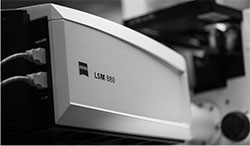Theanne Griffith, Ph.D.

Assistant Professor
4135 Tupper Hall,
Davis Campus
530-754-2780
tgriffith@health.ucdavis.edu
Lab Website
Research Interests
The ability to navigate our physical environment relies not only on the detection of external cues, but also an accurate sense of internal spatial awareness. If you wake up in the morning with an arm across your face, how do you know it is yours, and not that of a partner or intruder? The answer is proprioception. This “sixth sense” allows us to make a physical distinction between “self” and “other” and is required for purposeful and coordinated movement. Despite the essential nature of proprioception to most daily tasks, our understanding of how internal sensory information drives motor behaviors is limited. Using a combination of mouse genetics, diverse electrophysiological preparations, behavior, molecular profiling, and imaging, we aim to: 1) Identify the ion channels that constitute the transmission machinery in proprioceptive sensory circuits and the mechanisms through which they control proprioceptor neuronal excitability and neurotransmission; 2) Understand how proprioceptive sensory information shapes spinal cord motor circuit formation and function; 3) Investigate the long-range effects of sensory proprioceptive signaling on brain motor centers; 4) Understand how our internal spatial awareness of self interfaces with other physiological processes.
Griffith TN, Docter, TA, Lumpkin EA (2019) "Tetrodotoxin-sensitive sodium channels mediate action potential firing and excitability in menthol-sensitive Vglut3-lineage sensory neurons". J Neurosci. 9(36):7086-7101.
Hoffman BU, Baba Y, Griffith TN, Mosharov EV, Woo SH, Roybal DD, Karsenty G, Patapoutian A, Sulzer D, and Lumpkin EA (2018) "Merkel cells activate sensory neural pathways through adrenergic synapses". Neuron. 100(6):1401-1413.
Griffith TN & Swanson GT (2015) "Identification of critical functional determinants of kainate receptor modulation by auxiliary protein Neto2". J Physiol. 593(22):4815-33. Comment in: Howe JR (2015) Auxiliary subunits highlight a role for the LBD–TMD linkers in glutamate receptor desensitization. J Physiol. 593(22):4813-4.
VanLeeuwen JE, Rafalovich I, Sellers K, Jones KA, Griffith TN, Huda R, Miller RJ, Srivastava DP, Penzes P (2014) "Coordinated nuclear and synaptic shuttling of afadin promotes spine plasticity and histone modifications". J Biol. Chem. 289(15):10831-42.
Inestrosa NC, Tapia-Rojas C, Griffith TN, Carvajal FJ, Benito MJ, Rivera-Dictter A, Alvarez AR, Serrano FG, Hancke JL, Burgos PV, Parodi J, Valera-Nallar L (2011) "Tetrahydrohyperforin prevents cognitive deficit, Ab deposition, tau phosphorylation and synaptotoxicity in the APPswe/PSEN1"E9 model of Alzheimer’s disease: A possible effect on APP processing". Transl Psychiatry 1: e20;doi:10.1038/tp.2011.19.
Griffith TN, Varela-Nallar L, Dinamarca MC, Inestrosa NC (2009) "Neurobiological effects of hyperforin and its potential in Alzheimer's Disease Therapy". Curr Med Chem 17(5):391-406.
Hall AC, Griffith TN, Tsikolia M, Kotey FO, Gill N, Humbert DJ, Watt EE, Yermolina YA, Goel S, El-Ghendy B, Hall CD (2011) "Cyclohexanol analogues are positive modulators of GABA(A) receptor currents and act as general anesthetics in vivo". Eur J Pharmacol 667(1-3):175-81.
Watt EE, Betts BA, Kotey FO, Humbert DJ, Griffith TN, Kelly EW, Veneskey KC, Gill N, Rowan KC, Jenkins A, Hall AC (2008) "Menthol shares general anesthetic activity and sites of action on the GABAA receptor with the intravenous agent, propofol". Eur J Pharmacol 590(1-3):120-6.




 Make a donation using our secure online system.
Make a donation using our secure online system.